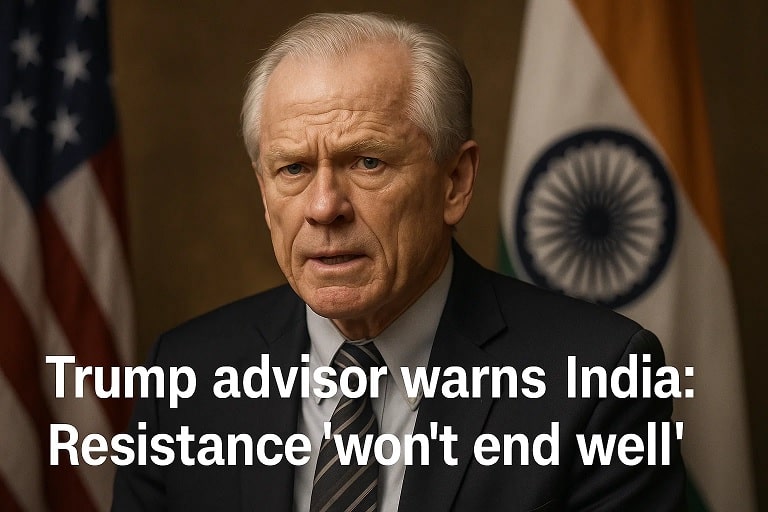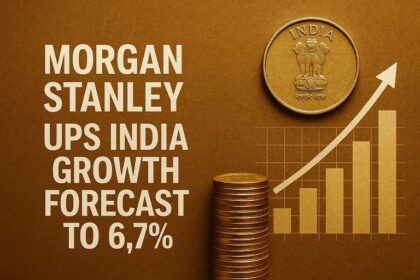Trump Advisor Warns India: Resistance ‘Won’t End Well’ Amid Tariff Tensions
Introduction
On September 8, 2025, Peter Navarro, a key trade advisor to US President Donald Trump, issued a stark warning to India, stating that resistance to US trade demands “won’t end well” for New Delhi if it continues to align with Russia and China. Speaking on Real America’s Voice, Navarro criticized India’s high tariffs on US goods and its increased purchases of Russian oil following the Ukraine invasion, dubbing India the “Maharajah of tariffs.” This comes amid escalating US-India trade frictions, with Trump imposing 50% tariffs on Indian imports (excluding pharmaceuticals and energy) effective August 27, 2025, potentially costing India $87 billion in exports. The remarks, part of Navarro’s broader attack on the BRICS alliance, highlight deteriorating bilateral ties. This article explores the drivers behind Navarro’s warning, historical context, future implications, and impacts, with a focus on India’s strategic response and Tamil Nadu’s role in bolstering domestic manufacturing resilience.
Why This Warning Matters
Navarro’s threat underscores the Trump administration’s aggressive “America First” trade policy, targeting India’s $99 billion trade surplus with the US and its Russian oil imports, which surged 120% since 2022. As a former White House advisor instrumental in the 2018 US-China trade war, Navarro’s comments signal potential escalation, including secondary sanctions on Indian firms dealing with Russia. For India, navigating this requires balancing strategic autonomy with economic ties to the US, its largest export market. Tamil Nadu, a manufacturing powerhouse for electronics and textiles, faces direct risks from tariffs but opportunities in “Make in India 2.0,” potentially adding ₹8,000 crore to the state’s GDP through supply chain diversification.
Latest Developments Driving the Warning
Navarro’s September 8 remarks were the latest in a series of US rebukes, triggered by stalled trade negotiations and India’s BRICS alignment. Key events include:
- Navarro’s Statements: Navarro accused India of “profiteering” with Russian refiners on Indian soil and using US trade dollars to buy Moscow’s oil. He warned, “India must come around at some point. And if it doesn’t, it’s lying down with Russia and China, and that won’t end well for India.” He also dismissed BRICS as unsustainable without US markets.
- Tariff Imposition: Trump’s 50% tariffs (25% base + 25% on Russian oil ties) on $87 billion Indian exports, effective August 27, 2025, hit textiles, gems, and machinery hardest, prompting a $3 billion FII outflow and rupee depreciation to 88 per dollar.
- BRICS Backlash: Navarro’s comments followed the SCO Summit in Tianjin (September 1, 2025), where Modi, Xi, and Putin met, drawing Trump’s ire. Former NSA John Bolton noted the Trump-Modi “bromance” has ended, warning of Trump’s unpredictability.
- Indian Response: Chief Economic Advisor V. Anantha Nageswaran called tariffs “short-lived,” emphasizing India’s non-alignment. PM Modi plans a China visit and NSA Ajit Doval’s Russia trip to diversify ties.
- Trade Stalemate: Negotiations for a $500 billion bilateral target by 2030 stalled; India increased US oil buys 120% but resists market opening.
Tamil Nadu’s Context
Tamil Nadu’s textile exports ($3 billion to US) face 50% tariffs, risking 1 lakh jobs in Tiruppur, but its electronics hub (Foxconn, TSMC) is exempt, positioning the state for PLI-driven diversification and ₹8,000 crore in new investments.
Historical Context of US-India Trade Tensions
US-India trade relations have oscillated between cooperation and friction:
- 2008: US-India Civil Nuclear Deal boosted ties; bilateral trade reached $120 billion.
- 2018: Trump imposed steel/aluminum tariffs; India retaliated on US almonds, apples.
- 2019: Trump labeled India a “tariff king”; mini-trade deal talks failed.
- 2020-2023: Quad strengthened strategic ties; trade hit $190 billion, but surpluses irked Trump.
- 2024: Trump’s re-election reignited demands; India’s Russian oil imports (up 120%) drew ire.
- 2025: 50% tariffs imposed; Navarro’s warnings follow SCO Summit, signaling nadir in relations.
Tamil Nadu’s exports grew 15% in 2024, but tariffs threaten 20% contraction without diversification.
Future Scopes and Projections
Trade talks could yield a limited deal by 2026, but escalation risks persist. Projections include:
- Tariff Impacts: $10-15 billion annual loss; textiles/gems down 70%.
- Diversification: FTAs with UK/EAEU boost exports $20 billion; PLI attracts $50 billion FDI.
- Bilateral Trade: $500 billion target by 2030 via mini-deal on EVs/pharma.
- Geopolitical Shift: India deepens Russia-China ties; US secondary sanctions possible.
Long-Term Strategic Outlook
By 2030, India targets $1 trillion exports; Tamil Nadu could lead electronics self-reliance, adding ₹20,000 crore. Challenges: Rupee volatility, FII outflows ($3 billion), and BRICS tensions.
Impacts on the Indian Economy and Stakeholders
Tariffs could shave 0.5% off GDP, but diversification offers resilience.
Sector-Wise Impacts
Textiles and Gems
- Impact: 50% tariffs hit $40 billion exports; 1 lakh jobs at risk in Tamil Nadu’s Tiruppur.
- Economic Contribution: $5 billion loss; diversification to Vietnam saves 50%.
- Business Opportunities: Coimbatore shifts to EVs.
Electronics and EVs
- Impact: Exemptions protect $20 billion exports; PLI boosts Tamil Nadu’s Foxconn.
- Economic Contribution: $10 billion gains; Tamil Nadu 30%.
- Business Opportunities: Chennai semiconductors for US market.
Energy and Oil
- Impact: Secondary sanctions on Russian oil (40% imports); rupee hits 90/dollar.
- Economic Contribution: $15 billion savings via diversification.
- Business Opportunities: Tamil Nadu green hydrogen pilots.
Impact Snapshot
| Sector | Tariff Effect | Tamil Nadu Impact |
|---|---|---|
| Textiles/Gems | $5B loss | 1 lakh jobs at risk, diversification |
| Electronics/EVs | Exempt, $10B gains | Foxconn boost, 50,000 jobs |
| Energy/Oil | Sanctions risk | Green alternatives, ₹5,000 crore |
| Overall (2030) | $1T exports target | ₹20,000 crore GDP addition |
Frequently Asked Questions (FAQs)
What did Navarro warn?
India’s tariff resistance and Russian ties “won’t end well”; must align with US or face consequences.
Why the tariffs?
Retaliation for $99B surplus and Russian oil; 50% on $87B exports since August 2025.
How is India responding?
Diversifying via FTAs; CEA calls tariffs “short-lived”; Modi eyes China/Russia ties.
What’s Tamil Nadu’s risk?
Textiles face $1B hit, but electronics exempt; PLI adds ₹8,000 crore.
Future outlook?
Mini-deal by 2026; $500B trade target, but escalation risks persist.












